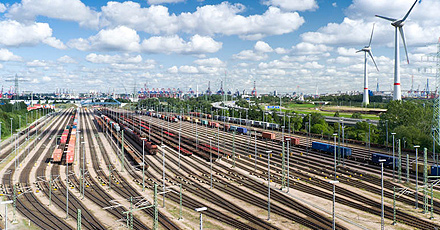
Hamburg is Europe‘s largest Port-Rail Hub
Fewer trucks on the road, less CO2 in the air: the Hamburg Port Railway offers the most eco-friendly connections between the container terminals and the international railway network. Its state-of-the-art rail freight infrastructure and IT-supported organisation make the Port Railway a perfect fit in the "Green Port" concept.
Every day more than 200 freight trains or 5,000 rail cars – carrying about one third of the total goods handled in the port – travel the tracks of the Port Railway. Around 2 million rail containers are moved annually, making the Port of Hamburg the largest freight rail hub in Europe. And the Port Railway even holds a world record: more than 110 rail freight operators (EVU) use its roughly 300 kilometres of rail tracks, showing clearly just how attractive the location is.
The Hamburg Port Authority (HPA) has continuously increased the Port Railway’s share in container and freight transports and invested heavily in infrastructure facilities, including links to international rail transport networks and the modernisation of the telematic railway IT systems. Capacity utilisation is now automatically and accurately captured, which makes it a lot easier to plan capacities and coordinate operating processes more efficiently. An incentive-based billing system shortens the time wagons stand idle on tracks. The Port Railway is well placed to cater to future developments in freight transport.
Every day more than 200 freight trains or 5,000 rail cars – carrying about one third of the total goods handled in the port – travel the tracks of the Port Railway. Around 2 million rail containers are moved annually, making the Port of Hamburg the largest freight rail hub in Europe. And the Port Railway even holds a world record: more than 110 rail freight operators (EVU) use its roughly 300 kilometres of rail tracks, showing clearly just how attractive the location is.
The Hamburg Port Authority (HPA) has continuously increased the Port Railway’s share in container and freight transports and invested heavily in infrastructure facilities, including links to international rail transport networks and the modernisation of the telematic railway IT systems. Capacity utilisation is now automatically and accurately captured, which makes it a lot easier to plan capacities and coordinate operating processes more efficiently. An incentive-based billing system shortens the time wagons stand idle on tracks. The Port Railway is well placed to cater to future developments in freight transport.
smartNEWS



